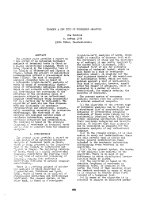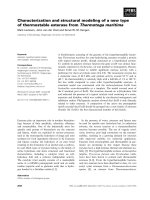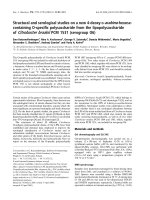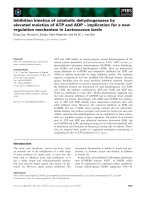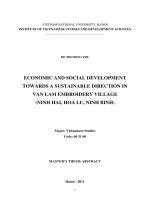- Trang chủ >>
- Khoa Học Tự Nhiên >>
- Vật lý
Quantum physics, relativity, and complex spacetime; towards a new synthesis
Bạn đang xem bản rút gọn của tài liệu. Xem và tải ngay bản đầy đủ của tài liệu tại đây (11.69 MB, 377 trang )
QUANTUM PHYSICS, RELATIVITY,
AND COMPLEX SPACETIME
Towards a New Synthesis
www.pdfgrip.com
NORTH-HOLLAND MATHEMATICS STUDIES 163
(Continuation of the Notas de Matematica)
Editor: Leopoldo NACHBIN
Centro Brasileiro de Pesquisas Fisicas
Rio de Janeiro, Brazil
and
University of Rochester
New York, U.S.A.
NORTH-HOLLAND - AMSTERDAM
NEW YORK
OXFORD
www.pdfgrip.com
TOKYO
QUANTUM PHYSICS,
RELATIVITY, AND
COMPLEX SPACETIME
Towards a New Synthesis
Gerald KAISER
Department of Mathematics
University of Lowell
Lowell, MA, USA
1990
NORTH-HOLLAND -AMSTERDAM
NEW YORK
OXFORD TOKYO
www.pdfgrip.com
ELSEVIER SCIENCE PUBLISHERS B.V.
Sara Burgerhartstraat 25
P.O. Box 211, 1000 AE Amsterdam, The Netherlands
Distributors for the U.S.A. and Canada:
ELSEVIER SCIENCE PUBLISHING COMPANY, INC.
655 Avenue of the Americas
NewYork, N.Y. 10010, U.S.A.
Library o f Congress Cataloging-in-Publlcation Data
Kaiser, Gerald.
Ouantun physics. relativity. and complex spacetine : towards a new
SynthEbiS / Gerald Kaiser.
p.
cn. -- (North-Holland matheiatlcs studies ; 163)
Includes b l b l i O Q r ~ p h i C ~references
1
and index.
ISBN 0-444-88465-3
1. Quantum theory. 2. Relativity (Physics) 3. S p a c e and tine.
4. Mathematical physics.
I. Title. 11. Serios.
QC174.12.K34
1990
530.1'2--dc20
90-7979
CIP
ISBN: 0 444 88465 3
Q ELSEVIER SCIENCE PUBLISHERS B.V., 1990
All rights reserved. No part of this publication may be reproduced, stored in a retrieval
system, or transmitted, in any form or by any means, electronic, mechanical, photocopying,
recording or otherwise, without the prior written permission of the publisher, Elsevier
Science Publishers B.V. / Physical Sciences and Engineering Division, P.O. Box 103, 1000 AC
Amsterdam, The Netherlands.
Special regulations for readers in the U.S.A. - This publication has been registered with the
Copyright Clearance Center Inc. (CCC), Salem, Massachusetts. Information can be obtained
from the CCC about conditions under which photocopies of parts of this publication may be
made in the U.S.A. All other copyright questions, including photocopying outside of the
USA., should be referred to the publisher.
NO responsibility is assumed by the publisher for any injury and/or damage to persons or
property as a matter of products liability, negligence or otherwise, or from any use or
operation of any methods, products, instructions or ideas contained in the material herein.
Printed in The Netherlands
www.pdfgrip.com
To my parents, Bernard and Cesia
and to Janusz, Krystyn, Mirek and Renia
www.pdfgrip.com
This Page Intentionally Left Blank
www.pdfgrip.com
Vii
UNIFIED FIELD THEORY
In the beginning there was Aristotle,
And objects at rest tended to remain at rest,
And objects in motion tended to come to rest,
And soon everything was at rest,
And God saw that it was boring.
Then God created Newton,
And objects at rest tended to remain at rest,
But objects in motion tended to remain in motion,
And energy was conserved and momentum was conserved and
matter was conserved,
And God saw that it was conservative.
Then God created Einstein,
And everything was relative,
And fast things became short,
And straight things became curved,
And the universe was filled with inertial frames,
And God saw that it was relatively general, but some of it was
especially relative.
Then God created Bohr,
And there was the principle,
And the principle was quantum,
And all things were quantized,
But some things were still relative,
And God saw that it was confusing.
Then God was going to create Fergeson,
And Fergeson would have unified,
And he would have fielded a theory,
And all would have been one,
But it was the seventh day,
And God rested,
And objects at rest tend to remain at rest.
by Tim Joseph
copyright 01978 by The New York Times Company
Reprinted by permission.
www.pdfgrip.com
This Page Intentionally Left Blank
www.pdfgrip.com
ix
CONTENTS
Preface ........................................................
.xi
Suggestions to the Reader ..................................
xvi
.
Chapter 1 Coherent-State Representations
1.1. Preliminaries ............................................
1
1.2. Canonical coherent states ................................ 9
1.3. Generalized frames and resolutions of unity ............. 18
1.4.Reproducing-kernel Hilbert spaces ......................
29
34
1.5. Windowed Fourier transforms ...........................
1.6. Wavelet transforms .....................................
43
.
Chapter 2 Wavelet Algebras and Complex Structures
2.1. Introduction ............................................ 57
2.2. Operational calculus .................................... 59
2.3. Complex structure ......................................
70
2.4. Complex decomposition and reconstruction ............. 82
2.5. Appendix ..............................................
92
.
Chapter 3 Frames and Lie Groups
3.1. Introduction ............................................
95
3.2. Klauder’s group-frames .................................95
3.3. Perelomov’s homogeneous G-frames ................... 103
3.4. Onofri’s’s holomorphic G-frames .......................113
3.5. The rotation group ....................................
135
3.6. The harmonic oscillator as a contraction limit ..........145
www.pdfgrip.com
Contents
X
.
Chapter 4 Complex Spacetime
4.1. Introduction ...........................................
155
4.2. Relativity, phase space and quantization ............... 156
4.3. Galilean frames ........................................
169
183
4.4. Relativistic frames .....................................
4.5. Geometry and Probability .............................
207
4.6.The non-relativistic limit .............................. 225
Notes ...................................................... 230
.
Chapter 5 Quantized Fields
5.1. Introduction ...........................................
235
5.2. The multivariate Analytic-Signal transform ............239
5.3. Axiomatic field theory and particle phase spaces .......249
273
5.4. Free Klein-Gordon fields ..............................
5.5. Free Dirac fields ....................................... 289
5.6. Interpolating particle coherent states ..................302
5.7. Field coherent states and functional integrals .......... 308
Notes ......................................................
318
.
Chapter 6 Further Developments
6.1. Holomorphic gauge theory .............................
321
6.2. Windowed X-Ray transforms: Wavelets revisited ...... 334
..................................................
347
........................................................
357
References
Index
www.pdfgrip.com
xi
PREFACE
The idea of complex spacetime as a unification of spacetime and
classical phase space, suitable as a possible geometric basis for the
synthesis of Relativity and quantum theory, first occured to me in
1966 while I was a physics graduate student at the University of Wisconsin. In 1971, during a seminar I gave at Carleton University in
Canada, it was pointed out to me that the formalism I was developing was related to the coherent-state representation, which was then
unknown to me. This turned out to be a fortunate circumstance,
since many of the subsequent developments have been inspired by
ideas related to coherent states. My main interest at that time was
to formulate relativistic coherent states.
In 1974, I was struck by the appearance of tube domains in axiomatic quantum field theory. These domains result from the analytic
continuation of certain functions (vacuum expectaion values) associated with the theory to complex spacetime, and powerful methods
from the theory of several complex variables are then used to prove
important properties of these functions in real spacetime. However,
the complexified spacetime itself is usually not regarded as having
any physical significance. What intrigued me was the possibility that
these tube domains may, in fact, have a direct physical interpretation
as (extended) classical phase spaces. If so, this would give the idea of
complex spacetime a firm physical foundation, since in quantum field
theory the complexification is based on solid physical principles. It
could also show the way to the construction of relativistic coherent
states. These ideas were successfully worked out in 1975-76,culminating in a mathematics thesis in 1977 at the University of Toronto
entitled “Phasespace Approach to Relativistic Quantum Mechanics.”
www.pdfgrip.com
Xii
Preface
Up to that point, the theory could only describe free particles.
The next goal was to see how interactions could be added. Some
progress in this direction was made in 1979-80, when a natural way
was found to extend gauge theory to complex spacetime. Further
progress came during my sabbatical in 1985-86, when a method was
developed for extending quantized fields themselves (rather than their
vacuum expectation values) to complex spacetime. These ideas have
so far produced no “hard” results, but I believe that they are on the
right path.
Although much work remains to be done, it seems to me that
enough structure is now in place to justify writing a book. I hope
that this volume will be of interest to researchers in theoretical and
mathematical physics, mathematicians interested in the structure of
fundamental physical theories and assorted graduate students searching for new directions. Although the topics are fairly advanced, much
effort has gone into making the book self-contained and the subject
matter accessible to someone with an understanding of the rudiments
of quantum mechanics and functional analysis.
A novel feature of this book, from the point of view of mathematical physics, is the special attention given to “ signal analysis”
concepts, especially time-frequency localization and the new idea of
wavelets. It turns out that relativistic coherent states are similar to
wavelets, since they undergo a Lorentz contraction in the direction
of motion. I have learned that engineers struggle with many of the
same problems as physicists, and that the interplay between ideas
from quantum mechanics and signal analysis can be very helpful to
both camps. For that reason, this book may also be of interest to
engineers and engineering students.
The contents of the book are as follows. In chapter 1 the simplest
www.pdfgrip.com
Preface
Xiii
examples of coherent states and time-frequency localization are introduced, including the original “canonical” coherent states, windowed
Fourier transforms and wavelet transforms. A generalized notion of
frames is defined which includes the usual (discrete) one as well as
continuous resolutions of unity, and the related concept of a reproducing kernel is discussed.
In chapter 2 a new, algebraic approach to orthonormal bases of
wavelets is formulated. An operational calculus is developed which
simplifierthe formalism considerably and provides insights into its
symmetries. This is used to find a complex structure which explains
the symmetry between the low- and the high-frequency filters in
wavelet theory. In the usual formulation, this symmetry is clearly
evident but appears to be accidental. Using this structure, complex
wavelet decompositions are considered which are analogous to analytic coherent-state representations.
In chapter 3 the concept of generalized coherent states based on
Lie groups and their homogeneous spaces is reviewed. Considerable
attention is given to holomorphic (analytic) coherent-state representations, which result from the possibility of Lie group complexification. The rotation group provides a simple yet non-trivial proving
ground for these ideas, and the resulting construction is known as the
“spin coherent states.” It is then shown that the group associated
with the Harmonic oscillator is a weak contraction limit (as the spin
s 4 00) of the rotation group and, correspondingly, the canonical coherent states are limits of the spin coherent states. This explains why
the canonical coherent states transform naturally under the dynamics
generated by the harmonic oscillator.
In chapter 4,the interactions between phase space, quantum mechanics and Relativity are studied. The main ideas of the phasespace approach to relativistic quantum mechanics are developed for
www.pdfgrip.com
xiv
Preface
free particles, based on the relativistic coherent-state representations
developed in my thesis. It is shown that such representations admit
a covariant probabilistic interpretation, a feature absent in the usual
spacetime theories. In the non-relativistic limit, the representations
are seen to “contract” smoothly to representations of the Galilean
group which are closely related to the canonical coherent-state representation. The Gaussian weight functions in the latter are seen to
emerge from the geometry of the mass hyperboloid.
In chapter 5 , the formalism is extended to quantized fields. The
basic tool for this is the Analytic-Signal transform,which can be applied to an arbitrary function on R”to give a function on a!” which,
although not in general analytic, is “analyticity-friendly” in a certain sense. It is shown that even the most general fields satisfying
the Wightman axioms generate a complexification of spacetime which
may be interpreted as an extended classical phase space for certain
special states associated with the theory. Coherent-st ate represent ations are developed for free Klein-Gordon and Dirac fields, extending
the results of chapter 4. The analytic Wightman two-point functions
play the role of reproducing kernels. Complex-spacetime densities of
observables such as the energy, momentum, angular momentum and
charge current are seen to be regularizations of their counterparts in
real spacetime. In particular, Dirac particles do not undergo their
usual Zitterbewegung. The extension to complex spacetime separates, or polarizes, the positive- and negativefrequency parts of free
fields, so that Wick ordering becomes unnecessary. A functionalintegral represent ation is developed for quantized fields which combines the coherent-state representations for particles (based on a finite number of degrees of freedom) with that for fields (based on an
infinite number of degrees of freedom).
In chapter 6 we give a brief account of some ongoing work, begin-
www.pdfgrip.com
Preface
xv
ning with a review of the idea of holomorphic gauge theory. Whereas
in real spacetime it is not possible to derive gauge potentials and
gauge fields from a (fiber) metric, we show how this can be done in
complex spacetime. Consequently, the analogy between General Relativity and gauge theory becomes much closer in complex spacetime
than it is in real spacetime. In the “holomorphic” gauge class, the
relation between the (non-abelian) Yang-Mills field and its potential
becomes linear due to the cancellation of the non-linear part which
follows from an integrability condition. Finally, we come full circle by
generalizing the Analytic-Signal transform and pointing out that this
generalization is a higher-dimensional version of the wavelet transform which is, moreover, closely related to various classical transforms
such as the Hilbert, Fourier-Laplace and Radon transforms.
I am deeply grateful to G. Emch for his continued help and
encouragement over the past ten years, and to J. R. Klauder and
R. F. Streater for having read the manuscript carefully and made
many invaluable comments, suggestions and corrections. (Any remaining errors are, of course, entirely my responsibility.) I also thank
D. Buchholtz, F. Doria, D. Finch, S. Helgason, I. Kupka, Y. Makovoz,
J. E. Marsden, M. O’Carroll, L. Rosen, M. B. Ruskai and R. Schor
for miscellaneous important assistance and moral support at various
times. Finally, I am indebted to L. Nachbin, who first invited me to
write this volume in 1981 (when I was not prepared to do so) and
again in 1985 (when I was), and who arranged for a tremendously
interesting visit to Brazil in 1982. Quero tarnbkm agradecer a todos
0s meus colegas Brasileiros!
www.pdfgrip.com
xvi
Suggestions t o the Reader
The reader primarily interested in the phasespace approach to
relativistic quantum theory may on first reading skip chapters 1-3
and read only chapters 4-6, or even just chapter 4 and either chapters 5 or 6, depending on interest. These chapters form a reasonably self-contained part of the book. Terms defined in the previous
chapters, such as “frame,” can be either ignored or looked up using
the extensive index. The index also serves partially as a glossary
of frequently used symbols. The reader primarily interested in signal analysis, timefrequency localization and wavelets, on the other
hand, may read chapters 1 and 2 and skip directly to sections 5.2 and
6.2. The mathematical reader unfamiliar with the ideas of quantum
mechanics is urged to begin by reading section 1.1, where some basic
notions are developed, including the Dirac notation used throughout
the book.
www.pdfgrip.com
1
Chapter 1
COHERENT-STATE REPRESENTATIONS
1.1. Preliminaries
In this section we establish some notation and conventions which will
be followed in the rest of the book. We also give a little background on
the main concepts and formalism of non-relativistic and relativistic
quantum mechanics, which should make this book accessible to nonspecialists.
1. Spacetirne and its Dual
In this book we deal almost exclusively with flat spacetime, though we
usually let space be R"instead of R3,so that spacetime becomes X =
IRs+l. The reason for this extension is, first of all, that it involves
little cost since most of the ideas to be explored here readily generalize
to IRS+l, and furthermore, that it may be useful later. Many models
in constructive quantum field theory are based on two- or threedimensional spacetime, and many currently popular attempts to unify
physics, such as string theories and Kaluza-Klein theories, involve
spacetimes of higher dimensionality than four or (on the string worldsheet) two-dimensional spacetimes. An event x € X has coordinates
2
= ( 2 P ) = (xO,xj),
www.pdfgrip.com
1 . Coherent-St ate Represent ations
2
where x o
3
t is the time coordinate and x j are the space coordinates.
Greek indices run from 0 to s, while latin indices run from 1 to s. If
we think of x as a translation vector, then X is the vector space of
all translations in spacetime. Its dual
X* is the set of all linear maps
k : X + IR. By linearity, the action of k on x (which we denote by
k x instead of k ( x ) ) can be written as
5
kx =
C k,xp
k,xp,
(2)
,=o
where we adopt the Einstein summation convention of automatically
summing over repeated indices. Usually there is no relation between
x and k other than the pairing (x,k ) H kx. But suppose we are
given a scalar product on X ,
5 . 2I
=g,,x
CL x 'V
(3)
where (g,,) is a non-degenerate matrix. Then each x in X defines
a linear map x * : X +
*: X
---f
IR by
x*(x') = x
. x',
thus giving a map
X * , with
( x * ) , =- 5 , = g , , x Y
(4)
Since g,, is non-degenerate, it also defines a scalar product on X * ,
'
whose metric tensor is denoted by g"". The map x
x* establishes
an isomorphism between the two spaces, which we use to identify
them. If 2 denotes a set of inertial coordinates in free spacetime,
then the scalar product is given by
g,, = diag(c2,-1, -1,
- - - ,-1)
where c is the speed of light. X , together with this scalar product, is
called Minkowskian or Lorentzian spacetime.
www.pdfgrip.com
1.1. Preliminaxies
3
It is often convenient to work in a single space rather than the
dual pair X and X * . Boldface letters will denote the spatial parts of
vectors in X * . Thus x = ( t , -x), k = (ko, k ) and
where x . x' and k - x denote the usual Euclidean inner products in
IR".
2. Fourier ?f-ansforms
The Fourier transform of a function f : X + (E (which, to avoid
analytical subtleties for the present, may be assumed to be a Schwartz
test function; see Yosida [1971])is a function f:X * + a given by
where dz 3 dt d"x is Lebesgue measure on X . f can be reconstructed
from by the inverse Fourier transform, denoted by " and given by
3
f ( ~ =)
d k e-2xikzf ( k ) = (P)"(x),
(7)
where d k = dk0d"k denotes Lebesgue measure on X * M X . Note
that the presence of the 27r factor in the exponent avoids the usual
~ (27r)-'-' in front of the integrals.
need for factors of ( 2 ~ ) - ( " + ' ) /or
Physically, k represents a wave vector: ko v is a frequency in cycles
per unit time, and kj is a wave number in cycles per unit length. Then
the interpretation of the linear map k: X + 1R is that 27rkx is the
total radian phase gained by the plane wave g(x') = exp(-27rikxt)
through the spacetime translation x , i.e. 27rk "measures" the radian phase shift. Now in pre-quantum relativity, it was realized
www.pdfgrip.com
4
I. Coherent-St ate Representations
that the energy E combines with the momentum p to form a vector
p
( p , ) = (E,p) in X * . Perhaps the single most fundamental difference between classical mechanics and quantum mechanics is that
in the former, matter is conceived to be made of “dead sets” moving
in space while in the latter, its microscopic structure is that of waves
descibed by complex-valued wave functions which, roughly speaking,
represent its distribution in space in probabilistic terms. One important consequence of this difference is that while in classical mechanics
one is free to specify position and momentum independently, in quantum mechanics a complete knowledge of the distribution in space, i.e.
the wave function, determines the distribution in momentum space
via the Fourier transform. The classical energy is reinterpreted as
the frequency of the associated wave by Planck’s Ansatz,
where tL is Planck’s constant, and the classical momentum is reinterpreted as the wave-number vector of the associated wave by De
Broglie’s relation,
These two relations are unified in relativistic terms as p , = 27rlik,.
Since a general wave function is a superposition of plane waves, each
with its own frequency and wave number, the relation of energy and
momentum to the the spacetime structure is very different in quantum mechanics from what is was in classical mechanics: They become
operators on the space of wave functions:
or, in terms of x*,
www.pdfgrip.com
5
1.1. Preliminaries
This is, of course, the source of the uncertainty principle. In terms
of energy-moment um, we obtain the “quantum-mechanical” Fourier
transform and its inverse,
If f(s) satisfies a differential equation, such as t,,e Schrodinger
equation or the Klein-Gordon equation, then f ( p ) is supported on
an s-dimensional submanifold P of X * (a paraboloid or two-sheeted
hyperboloid, respectively) which can be parametrized by p E
R”.
We will write the solution as
where f ( p ) is, by a mild abuse of notation, the “restriction” of
P (actually, l f ( p > l 2 is a density on P ) and d p ( p )
f
to
p ( p ) d ” p is an
appropriate invariant measure on P. For the Schrodinger equation
p(p) = 1, whereas for the Klein-Gordon equation, p ( p ) = lpo I
Setting t = 0 then shows that f(p) is related to the initial wave
function by
G
-’.
where now
“-”
denotes the the s-dimensional inverse Fourier trans-
form of the function
f
on
P
fi?
IR”.
We will usually work with “natural units,” i.e. physical units
so chosen that h = c = 1. However, when considering the non-
www.pdfgrip.com
6
1. Coherent-State Representations
relativistic limit ( c + 00) or the classical limit (ti + 0), c or ti will
be reinserted into the equations.
3. Hilbert Space
Inner products in Hilbert space will be linear in the second factor and
antilinear in the first factor. Furthermore, we will make some discrete
use of Dirac’s very elegant and concise bra-ket notation, favored by
physicists and often detested or misunderstood by mathematicians.
As this book is aimed at a mixed audience, I will now take a few paragraphs to review this notation and, hopefully, convince mathematicians of its correctness and value. When applied to coherent-state
representat ions, as opposed to representat ions in which the positionor momentum operators are diagonal, it is perfectly rigorous. (The
bra-ket notation is problematic when dealing with distributions, such
as the generalized eigenvectors of position or momentum, since it tries
to take the “inner products” of such distributions.)
Let ‘FI be an arbitrary complex Hilbert space with inner product (-,-). Each element f E 7-t defines a bounded linear functional
f * : ? t + (Jby
The Riesz represent at ion theorem guarantees that the converse is also
true: Each bounded linear functional L : 3-1 +
for a unique
f
E 3-1. Define the bra
(fl
(fl
a has the form L = f *
corresponding to f by
= f* : 3-1 +
a.
(14)
Similarly, there is a one-to-one correspondence between vectors g E ‘H
and linear maps
www.pdfgrip.com
7
1.1. Preliminaries
1s):
c + ‘H
defined by
Is)(X) = Xg,
E
a,
(16)
which will be called kets. Thus elements of ‘H will be denoted alternatively by g or by 1s). We may now consider the composite map
bra-ke t
given by
(f I 9 ) P ) = f*(W
= Xf*(s>
= X(f, 9).
(18)
Therefore the “bra-ket” map is simply the multiplication by the inner product (f, g) (whence it derives its name). Henceforth we will
identify these two and write (flg) for both the map and the inner
product. The reverse composition
Is)(fl : ‘H 3-1
+
may be viewed as acting on kets to produce kets:
IS)(fl(lW = lg)((fIN)*
(20)
To illustrate the utility of this notation, as well as some of its
pitfalls, suppose that we have an orthonormal basis {gn} in H. Then
the usual expansion of an arbitrary vector f in H takes the form
n
n
www.pdfgrip.com
8
1. Coherent-State Representations
from which we have the “resolution of unity”
n
where I is the identity on ‘FI and the sum converges in the strong
operator topology. If { h,} is a second orthonormal basis, the relation
between the expansion coefficients in the two bases is
In physics, vectors such as gn are often written as I n ) , which
can be a source of great confusion for mathematicians. Furthermore,
If),
with
functions in L2(IRB), say, are often written as f ( x ) = ( x
( x I 2’ ) = 6 ( x - 2 ’ ) ) as though the I x ))s formed an orthonormal basis.
This notation is very tempting; for example, the Fourier transform is
written as a “change of basis,”
with the “transformation matrix” ( k I x ) = exp(2~ikx). One of the
advantages of this notation is that it permits one to think of the
Hilbert space as “abstract,” with ( gn
If),
( h,
If
), ( x 1 f ) and ( k I f )
merely different “representat ions” (or “realizations”) of the same vector f . However, even with the help of distribution theory, this use
of Dirac notation is unsound, since it attempts to extend the Riesz
representation theorem to distributions by allowing inner products of
them. (The “vector” ( x I is a distribution which evaluates test func-
tions at the point z; as such, I x‘ ) does not exist within modern-day
distribution theory.) We will generally abstain from this use of the
bra-ket notation.
www.pdfgrip.com

